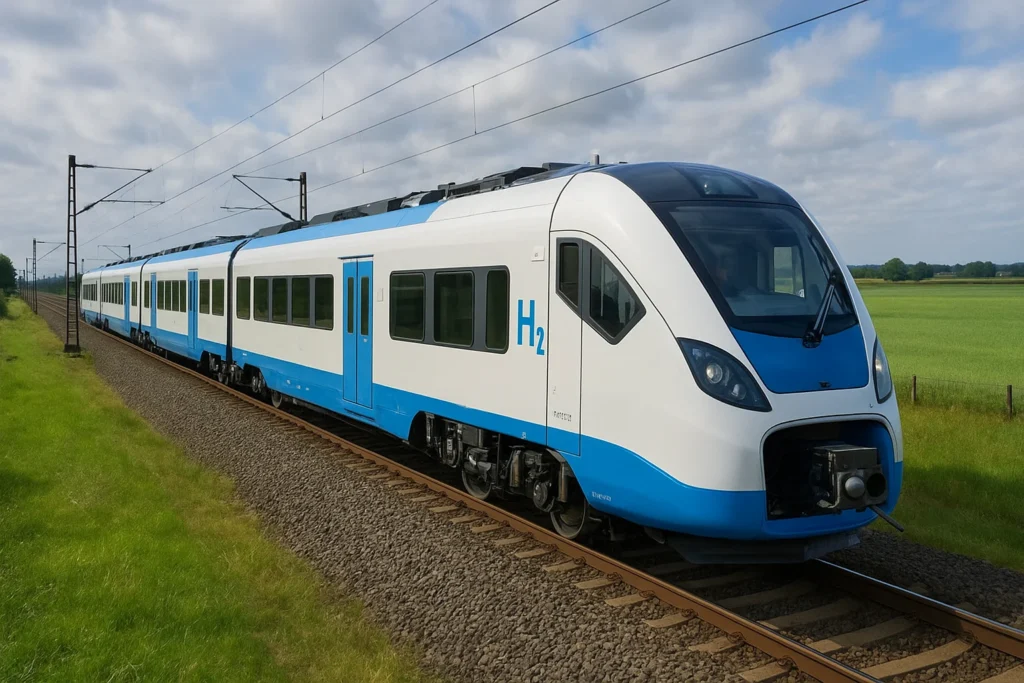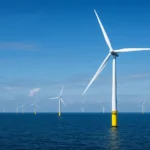The gentle whisper of hydrogen-powered trains is heralding a new age of European travel—one where borders blur, emissions vanish, and a shared vision for a greener future takes center stage.
Picture this: You’re waiting on the platform at Aachen Hauptbahnhof, a historic railway station that has witnessed over a century of European history. The familiar rumble of diesel engines has long defined this space, but today, something is different. The train that glides silently into the station bears the distinctive blue and white livery of the future—a hydrogen-powered marvel that will carry you across three nations without emitting a single gram of carbon dioxide. This is Europe’s bold new reality: the world’s first cross-border hydrogen train network now connects Germany, the Netherlands, and Belgium in an unprecedented demonstration of sustainable mobility. This isn’t merely a transportation upgrade; it’s a profound reimagining of how nations can collaborate, how technology can evolve, and how we can travel without costing the Earth.
The Historical Context: From Industrial Revolution to Green Revolution
The Steam Age: Europe’s First Rail Revolution
To truly appreciate the significance of hydrogen trains, we must first understand their place in the long arc of European rail history. The continent’s first railway lines emerged in the early 19th century, with steam engines literally driving the Industrial Revolution. These iron horses connected cities, moved goods, and shaped modern Europe—but at a tremendous environmental cost. The coal that powered them blackened skies and lungs alike, setting a pattern of progress at environmental expense that would continue for generations.
The Diesel Era: Power and Pollution
The mid-20th century saw diesel engines replace steam across much of Europe’s non-electrified rail network. While more efficient and powerful, these engines brought their own environmental problems—particulate matter, nitrogen oxides, and significant CO₂ emissions. Even as Europe became increasingly conscious of environmental issues in the late 20th century, these diesel workhorses continued to operate on approximately 40% of Europe’s rail network, particularly on secondary lines where electrification was deemed economically unviable.
The Electric Transition: Clean but Limited
Electrification became the gold standard for European rail in the late 20th and early 21st centuries, with countries like Switzerland and Belgium achieving nearly 100% electrification of their networks. But the enormous cost of installing overhead lines—between €1-2 million per kilometer—meant that many regional and cross-border routes remained diesel-dependent. This created a patchwork system where environmentally conscious travelers might board a clean electric train in one country only to transfer to a polluting diesel service to reach their final destination.
The Hydrogen Imperative: A Solution for the 21st Century
It’s against this backdrop that hydrogen technology emerged as the most promising solution for Europe’s non-electrified lines. Unlike full electrification, hydrogen trains don’t require massive infrastructure investment along the entire route. Instead, they need only hydrogen production and refueling facilities at strategic locations, making them economically viable for the less-traveled routes that nonetheless play a crucial role in European connectivity.
The Technology Deep Dive: How Hydrogen Trains Actually Work
The Fuel Cell: Heart of the Revolution
At the core of every hydrogen train lies the fuel cell—a technological marvel that essentially functions as a portable power plant. The Siemens Mireo Plus H trains deployed on the new cross-border route utilize proton exchange membrane (PEM) fuel cells, considered the most suitable for transportation applications. Here’s how the magic happens:
- Hydrogen Intake: Compressed hydrogen gas stored in roof-mounted tanks is fed to the anode side of the fuel cell.
- Electrochemical Reaction: A platinum catalyst splits the hydrogen molecules into protons (positively charged ions) and electrons.
- Power Generation: The protons pass through a specialized membrane, while the electrons are forced through an external circuit, creating an electric current that powers the train’s motors.
- Harmless Byproduct: On the cathode side, the protons, electrons, and oxygen from the air combine to form pure water—the only emission from the entire process.
This elegant process converts the chemical energy in hydrogen directly into electrical energy with remarkable efficiency—approximately 50-60%, compared to 30-35% for diesel engines.
The Battery Hybrid System: Maximizing Efficiency
What makes modern hydrogen trains like the Mireo Plus H particularly advanced is their hybrid configuration. Each train incorporates a lithium-ion battery that serves multiple crucial functions:
- Energy Storage: Captures energy from regenerative braking, similar to hybrid automobiles
- Power Boost: Provides additional power during acceleration or when climbing gradients
- Buffer Function: Smooths out power demand from the fuel cell, extending its lifespan
- Backup Power: Can operate the train for short distances if hydrogen is depleted
This combination allows the trains to achieve ranges up to 1,000 kilometers on a single tank of hydrogen while maximizing energy efficiency.
Refueling Infrastructure: The Hidden Backbone
The trains themselves represent only half the technological achievement. Equally impressive is the refueling infrastructure developed to support them. Hydrogen refueling for trains differs significantly from automotive applications:
- Higher Capacity: Train refueling stations must handle much larger volumes of hydrogen—a single multiple-unit train requires 200-400 kg of hydrogen for a full tank, compared to 5-10 kg for a typical fuel cell car.
- Rapid Refueling: The system is designed to completely refuel a train in under 20 minutes—comparable to diesel refueling times and essential for maintaining tight operational schedules.
- Safety Systems: Multiple redundant safety systems include leak detection, emergency shutdown procedures, and explosion-proof design features.
The refueling station in Bremervörde, Germany—the world’s first dedicated hydrogen train refueling facility—has become a model for similar installations across Europe.
The Cross-Border Network: Connecting Nations, Cultures, and Economies
The Route: Where Technology Meets Geography
The new hydrogen network connects key cities across three nations in a carefully planned corridor that maximizes both practical utility and symbolic importance:
- German Section: Cologne → Aachen (connecting with existing high-speed services to Frankfurt, Berlin, and beyond)
- Cross-Border Link: Aachen → Heerlen (Netherlands)
- Dutch Section: Heerlen → Maastricht → Sittard → Roermond
- Belgian Connection: Roermond → Hasselt → Leuven → Brussels
This 500-kilometer route serves multiple purposes: it connects important regional economic centers, provides alternative transportation for environmentally conscious travelers, and creates a visible demonstration of cross-border cooperation.
The Trains: Siemens Mireo Plus H in Detail
The specific trains deployed on this route represent the cutting edge of hydrogen rail technology:
- Speed: Capable of 160 km/h (100 mph), matching conventional regional trains
- Capacity: 150-200 seats per multiple-unit set
- Range: 800-1,000 kilometers on a single refueling
- Acceleration: 1.1 m/s², comparable to electric multiple units
- Noise Level: Significantly quieter than diesel trains (approximately 60 dB vs. 75-80 dB)
These specifications make the trains not just environmentally superior to their diesel counterparts, but operationally competitive as well.
Operational Realities: Making Hydrogen Work in Practice
Implementing a cross-border hydrogen network involves overcoming numerous practical challenges:
- Regulatory Harmonization: Coordinating safety regulations, operational procedures, and certification requirements across three different national systems
- Maintenance Protocols: Developing shared maintenance facilities and training technicians from multiple countries on the new technology
- Timetable Integration: Seamlessly integrating hydrogen services into existing national timetables and connection patterns
- Crew Training: Educating drivers and onboard staff from different rail companies on the unique characteristics of hydrogen trains
The successful navigation of these challenges provides a blueprint for future cross-border hydrogen initiatives throughout Europe.
The Hydrogen Ecosystem: Beyond the Rails
Green Hydrogen Production: The Fuel of the Future
For hydrogen trains to achieve their full environmental potential, the hydrogen itself must be produced using renewable energy—what’s known as “green hydrogen.” Europe is making massive investments in this area:
- Electrolyzer Capacity: The EU aims to install 40 GW of electrolyzer capacity by 2030, enough to produce approximately 10 million tonnes of renewable hydrogen annually
- North Sea Wind Farms: Massive offshore wind installations in the North Sea are being coupled with electrolysis facilities to produce hydrogen directly at sea
- Solar Hydrogen: Southern European countries like Spain and Portugal are leveraging their abundant solar resources for hydrogen production
- Energy Storage Function: Hydrogen production provides crucial energy storage, helping to balance grid fluctuations caused by intermittent renewable sources
Pipeline Infrastructure: The Hydrogen Highway
Parallel to the rail developments, Europe is building a dedicated hydrogen pipeline network that will eventually span the continent:
- Repurposed Infrastructure: Many projects, like the MosaHYc initiative between France and Germany, are converting existing natural gas pipelines for hydrogen transport
- New Construction: Purpose-built hydrogen pipelines are being developed in industrial clusters and between production and consumption centers
- Cross-Border Links: The European Hydrogen Backbone initiative envisions a pan-European network of 40,000 km of dedicated hydrogen pipelines by 2040
This infrastructure will serve not only trains but also industry, heating, and other transportation modes, creating a comprehensive hydrogen economy.
Economic Impact: Jobs, Innovation, and Investment
The hydrogen transition is generating significant economic benefits across Europe:
- Manufacturing Jobs: Companies like Siemens Mobility and Alstom are creating thousands of jobs in hydrogen train manufacturing
- Infrastructure Employment: The construction and maintenance of hydrogen production and distribution facilities represents a growing employment sector
- Research and Development: Universities and private companies across Europe are engaged in hydrogen technology research, positioning EU companies as global leaders
- Export Opportunities: European hydrogen technology and expertise are becoming valuable export commodities to markets worldwide
Environmental Impact: Quantifying the Benefits
Emissions Reduction: The Numbers Tell the Story
The environmental benefits of hydrogen trains are substantial and measurable:
- Direct Emissions: Zero carbon dioxide, nitrogen oxides, and particulate matter from train operations
- Well-to-Wheel Analysis: When powered by green hydrogen, the complete energy cycle produces minimal emissions—approximately 5-10 grams of CO₂ equivalent per passenger kilometer, compared to 30-40 grams for electric trains (on average EU grid mix) and 80-100 grams for diesel trains
- Annual Savings: The initial cross-border network alone will reduce CO₂ emissions by approximately 20,000 tonnes annually—equivalent to taking 4,000 cars off the road
- Noise Pollution Reduction: Hydrogen trains operate at significantly lower noise levels, particularly beneficial for urban areas and nighttime operations
Beyond Carbon: Additional Environmental Benefits
The advantages extend beyond greenhouse gas reductions:
- Air Quality Improvement: Elimination of diesel exhaust improves air quality in stations and along rail corridors
- Reduced Habitat Fragmentation: Unlike new highways or expanded rail lines, hydrogen conversion requires minimal new land use
- Water Production: Each hydrogen train produces clean water as a byproduct, which can be used for onboard sanitation systems or safely released
- Energy Diversity: Hydrogen trains reduce dependence on imported fossil fuels, enhancing energy security
The Challenges: Overcoming Obstacles to Adoption
Technical Hurdles: Pushing the Boundaries of Innovation
Despite the progress, significant technical challenges remain:
- Energy Efficiency: While improving, the well-to-wheel efficiency of hydrogen trains (25-35%) still trails behind battery electric options (70-80%)
- Cold Weather Performance: Fuel cells can experience reduced efficiency in freezing temperatures, requiring specialized engineering solutions
- Weight Considerations: Hydrogen storage tanks and fuel cells add weight compared to diesel systems, potentially affecting track wear
- Durability: Fuel cell lifespan, while improving, still doesn’t match diesel engines in some applications
Infrastructure Deployment: The Chicken and Egg Problem
Building the necessary hydrogen infrastructure presents classic coordination challenges:
- Production Facilities: Large-scale hydrogen production requires significant investment that depends on assured demand
- Distribution Networks: Pipeline and truck transport systems need to be developed in parallel with production and consumption
- Refueling Stations: Strategic placement of refueling infrastructure is essential for operational flexibility
- Storage Solutions: Large-scale hydrogen storage presents technical challenges due to hydrogen’s low density
Economic Considerations: Making the Numbers Work
The financial aspects of hydrogen adoption require careful management:
- Capital Costs: Hydrogen trains currently cost 30-50% more than comparable diesel units
- Fuel Costs: Green hydrogen remains more expensive than diesel on an energy-equivalent basis, though prices are falling rapidly
- Infrastructure Investment: The necessary production, storage, and distribution infrastructure requires billions in investment
- Financing Models: New public-private partnership structures are being developed to share risk and reward
Regulatory Frameworks: Building the Policy Foundation
Effective regulation is essential for widespread adoption:
- Safety Standards: Harmonized safety regulations across borders are necessary for cross-border operations
- Certification Processes: Streamlined certification for hydrogen equipment accelerates deployment
- Subsidy Structures: Intelligent subsidies can bridge the cost gap during the early adoption phase
- Carbon Pricing: Effective carbon pricing improves the economic case for hydrogen versus fossil alternatives
Case Studies: Learning from Pioneering Projects
The Coradia iLint: Proof of Concept
Alstom’s Coradia iLint, the world’s first hydrogen-powered passenger train, began service in Germany in 2018 and has provided invaluable operational experience:
- Performance Data: Over 200,000 kilometers of operational experience in regular service
- Reliability Metrics: Availability rates comparable to conventional trains after initial teething problems
- Public Acceptance: Overwhelmingly positive response from passengers and crews
- Lessons Learned: Informed design improvements in subsequent hydrogen train models
The Mireo Plus H: Next Generation Technology
Siemens’ Mireo Plus H represents the second generation of hydrogen trains, incorporating lessons from earlier projects:
- Integrated Design: More compact fuel cell system with better power-to-weight ratio
- Advanced Energy Management: Sophisticated software optimizes the interplay between fuel cell, battery, and traction systems
- Modular Architecture: Allows for customization based on specific route requirements
- Improved Efficiency: 30% better energy efficiency compared to earlier hydrogen train designs
The MosaHYc Project: Building the Hydrogen Highway
The MosaHYc pipeline project between France, Luxembourg, and Germany demonstrates the infrastructure side of the hydrogen revolution:
- Repurposing Expertise: Developing new techniques for converting natural gas pipelines to hydrogen service
- Cross-Border Coordination: Establishing new models for international infrastructure development
- Scaling Solutions: Creating replicable models for similar projects throughout Europe
- Stakeholder Engagement: Bringing together diverse interests including governments, industry, and local communities
The Future Vision: Where Do We Go From Here?
Phase 1: Regional Expansion (2023-2027)
The immediate future will see the rapid expansion of hydrogen rail networks across Europe:
- Scaling Existing Corridors: Extending the initial network to connect additional cities and regions
- New National Projects: Countries like Italy, Poland, and the UK are developing their own hydrogen rail initiatives
- Technology Standardization: Developing common standards to reduce costs and improve interoperability
- Cost Reduction: Achieving economies of scale in train manufacturing and hydrogen production
Phase 2: Continental Integration (2028-2035)
The middle phase will focus on creating a truly integrated European hydrogen network:
- Trans-European Corridors: Developing major hydrogen rail arteries connecting Northern and Southern Europe
- Hydrogen Backbone Completion: Finishing the core network of hydrogen pipelines across Western Europe
- Market Maturation: Achieving cost parity with diesel and establishing mature markets for hydrogen equipment and services
- Export Leadership: European companies establishing dominant positions in global hydrogen technology markets
Phase 3: Full Decarbonization (2036-2050)
The final phase will see hydrogen technology become ubiquitous throughout the European transport system:
- Complete Diesel Replacement: Phasing out the last diesel trains from European railways
- Multi-Modal Integration: Creating seamless connections between hydrogen trains, buses, and other clean transport options
- Global Climate Impact: European technology and expertise contributing to global decarbonization efforts
- New Applications: Expanding hydrogen technology to shipping, aviation, and other hard-to-decarbonize sectors
Conclusion: A New Chapter in European History
The launch of Europe’s first cross-border hydrogen train network represents far more than a technological achievement. It marks a pivotal moment in European history—a demonstration that the continent can harness its technological prowess, political unity, and economic power to address the defining challenge of our time.
As these whisper-quiet trains glide between German industrial centers, Dutch trading hubs, and Belgian administrative capitals, they carry with them a powerful message: that economic progress and environmental sustainability are not opposing forces, but complementary goals. They demonstrate that cross-border cooperation can produce results far greater than any nation could achieve alone.
The journey ahead remains long, with technical challenges to overcome, investments to make, and infrastructures to build. But with the successful launch of this pioneering network, Europe has taken the most difficult step—the first one. The foundation has been laid, the technology proven, and the commitment made. The hydrogen age of European rail has begun, and its progress will be worth watching not just for transportation enthusiasts or environmental advocates, but for anyone interested in how human ingenuity can build a better future.



